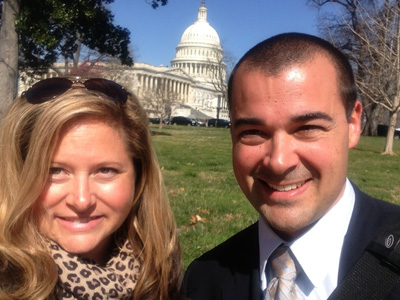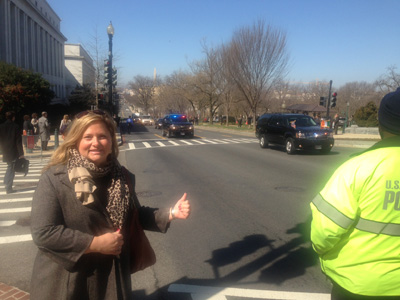NPMA Legislative Day in Washington - Clark Pest Control
Clark Pest Control's Nicole Keefe and Darren Van Steenwyk Attend the NPMA Legislative Day in Washington
If you weren’t born looking like the little mustachioed guy in the top hat from the Monopoly game, perhaps the best way to get a sit-down audience with your representative or senator in Congress, along with their attention, is to go as part of a group focused on making change happen. Which is why every spring, the National Pest Management Association hosts an annual NPMA Legislative Day in Washington. This year’s three-day session took place March 17-19. Clark Pest Control participated in the event by sending two executives, Technical Director Darren Van Steenwyk and Marketing Director Nicole Keefe.
A number of at-large events took place – hosted luncheons and presentations with legislators and industry people, along with various meetings and breakout sessions. However, the event was structured so that participants could set up appointments on one of the days to meet with senators or representatives from their home states. Seven of the nine California representatives who participated in the event hail from districts that Clark Pest Control services. Van Steenwyk and Keefe met with some of them, or their staffers, to talk about issues pertinent to business in general and pest management in particular.
“The legislators were receptive to us – a lot more than in the past,” Van Steenwyk says.
 Keefe agrees with Van Steenwyk, in that the event was a success. “I don’t know if attitudes are changing,” she says, “but no matter which side of the fence we were talking to, they were receptive, they were engaged, they were listening, they seemed like they knew what we were talking about, and I haven’t had that experience the last couple of years.”
Keefe agrees with Van Steenwyk, in that the event was a success. “I don’t know if attitudes are changing,” she says, “but no matter which side of the fence we were talking to, they were receptive, they were engaged, they were listening, they seemed like they knew what we were talking about, and I haven’t had that experience the last couple of years.”
The game plan was to focus on three issues of importance to Californians, and California pest control operators (PCOs), that the NPMA had identified.
One issue has to do with how information is passed on to consumers; the language used in consumer-affairs laws in some states, California included, mandates that pesticide disclosure notices, service records and certain other pieces of information must be delivered to every consumer via hard copy. Many companies and customers are working hard to manage resources better and reduce waste, and would prefer to receive that information as, say, a PDF sent via e-mail instead. If the requirement was changed, companies like Clark Pest Control – which has embraced S.M.A.R.T. (Sustainable Methods and Responsible Treatments) business practices to better serve its customers and meet their needs – could cut back on paper use by notifying customers electronically.
“That’s an example of where consumer attitudes are far ahead of our industry’s ability to meet consumer attitudes,” Keefe says. “The other thing we have to do is hold on to records, like termite inspections, for three years. It becomes quite cumbersome and expensive for a company when you have to find space to hold all of that, rather than sticking it on a server that could occupy one tidy little spot.” Instead of pushing to get legislation passed state by state, Keefe says the NPMA is advocating an amendment to the Federal Insecticide, Fungicide, and Rodenticide Act, or FIFRA, which would supersede current state laws.
Another issue arises from the way a 1987 law that authorizes the Department of Agriculture’s Wildlife Services program to manage nuisance birds and mammals in non-agricultural settings has been interpreted in the years since. While the law may have been written to give government employees the authority to manage bird problems at airports and deal with other wildlife-related issues, its broadly scoped language allows government agencies to compete with private-sector businesses, such as pest control companies, to control rats, mice and other vertebrate pests. The bipartisan Pest Elimination Services Transparency & Terminology (PESTT) Act (H.R. 730) defines the term “urban rodent control,” and directs the Government Accountability Office (GAO) to write a report that not only identifies actions that the Wildlife Services program performs that could be handled by the private sector, but makes recommendations on how to avoid competition in the future.
“What has happened, and we understand it’s through budget cuts, is that the Wildlife Services program has been supplementing its budget by actually doing pest control work that directly competes with us in the private sector,” Keefe says. “This last year, they did around $71 million of pest control work that could have been done by the private sector. That wasn’t the intention when it was formed.”
The third issue centers around the use of the gas sulfuryl fluoride, or SF, a broad-spectrum fumigant that had been championed by the EPA as a replacement for methyl bromide, which was phased out globally after being identified as an ozone-depleting chemical in the 1990s. In January 2011, the EPA issued a proposed order to revoke the use of SF to treat food items – various bulk commodities such as rice, dried fruit, cocoa, peanuts, walnuts and other items – and as a fumigant in grain mills and food-processing facilities, largely to avoid lawsuits from anti-fluoridation groups, even though, according to the EPA, the fluoride present in SF fumigations represents a tiny fraction of fluoride exposure to the public. What the EPA then did was it lumped naturally occurring fluoride in drinking water systems, a non-pesticide, in with SF fumigants when evaluating risk assessment for SF per Sec. 408 of the Federal Food, Drug, and Cosmetic Act (FFDCA); the EPA already regulates drinking-water fluoride with the Safe Drinking Water Act. The problem arises when drinking-water fluoride, especially in places where it occurs naturally in excess, maxes out the “risk cup” for the aggregate exposure assessment for SF, which removes the fumigant from consideration for use. A legislative fix would remove drinking-water fluoride from the “risk cup” for sulfuryl fluoride.
fumigant that had been championed by the EPA as a replacement for methyl bromide, which was phased out globally after being identified as an ozone-depleting chemical in the 1990s. In January 2011, the EPA issued a proposed order to revoke the use of SF to treat food items – various bulk commodities such as rice, dried fruit, cocoa, peanuts, walnuts and other items – and as a fumigant in grain mills and food-processing facilities, largely to avoid lawsuits from anti-fluoridation groups, even though, according to the EPA, the fluoride present in SF fumigations represents a tiny fraction of fluoride exposure to the public. What the EPA then did was it lumped naturally occurring fluoride in drinking water systems, a non-pesticide, in with SF fumigants when evaluating risk assessment for SF per Sec. 408 of the Federal Food, Drug, and Cosmetic Act (FFDCA); the EPA already regulates drinking-water fluoride with the Safe Drinking Water Act. The problem arises when drinking-water fluoride, especially in places where it occurs naturally in excess, maxes out the “risk cup” for the aggregate exposure assessment for SF, which removes the fumigant from consideration for use. A legislative fix would remove drinking-water fluoride from the “risk cup” for sulfuryl fluoride.
“That’s actually a really scary development that could cost a lot of jobs in our area,” Keefe says, “when you think of all the almonds, all the rice – those are all commodities that are treated with sulfuryl fluoride, because [the EPA] took away methyl bromide. Without sulfuryl fluoride, there’s nothing; all that industry, that processing, would go overseas.”


